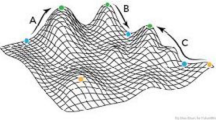Abstract
Organisms’ environments are thought to play a fundamental role in determining their fitness and hence in natural selection. Existing intuitive conceptions of environment are sufficient for biological practice. I argue, however, that attempts to produce a general characterization of fitness and natural selection are incomplete without the help of general conceptions of what conditions are included in the environment. Thus there is a “problem of the reference environment”—more particularly, problems of specifying principles which pick out those environmental conditions which determine fitness. I distinguish various reference environment problems and propose solutions to some of them. While there has been a limited amount of work on problems concerning what I call “subenvironments”, there appears to be no earlier work on problems of what I call the “whole environment”. The first solution I propose for a whole environment problem specifies the overall environment for natural selection on a set of biological types present in a population over a specified period of time. The second specifies an environment relevant to extinction of types in a population; this kind of environment is especially relevant to certain kinds of long-term evolution.
Similar content being viewed by others
References
Abrams M. (2005). Teleosemantics without natural selection. Biology and Philosophy 20(1): 97–116
Abrams M. (2007). Fitness and propensity’s annulment?. Biology and Philosophy 22: 115–130
Bharucha-Reid, A. T. (1996) [1960]. Elements of the theory of Markov processes and their applications. Dover.
Bigelow J., Pargetter R. (1987). Functions. Journal of Philosophy 84(4): 181–196
Bouchard F., Rosenberg A. (2004). Fitness, probability, and the principles of natural selection. British Journal for the Philosophy of Science 55(4): 693–712
Brandon, R. N. (1990). Adaptation and environment. Princeton University.
Byerly H.C., Michod R.E. (1991). Fitness and evolutionary explanation. Biology & Philosophy 6: 1–22
Campbell D.T. (1958). Common fate, similarity, and other indices of the status of aggregates of persons as social entities. Behavioral Science 3: 14–25
Colwell, R.K. (1992). Niche: a bifurcation in the conceptual lineage of the term. in (Keller and Lloyd 1992), pp. 241–248
Ewens, W. J. (2004). Mathematical population genetics, I. theoretical introduction(2nd ed.). Springer.
Gillespie, J.~H. (1998). Population genetics: A concise guide. The Johns Hopkins University Press.
Griesmer, J. R. (1992). Niche: Historical perspectives. in (Keller and Lloyd 1992), pp. 231–240.
Grimmett, G. R., & Stirzacker, D. R. (1992). Probability and random processes(2nd ed.). Oxford University Press.
Keller, E. F., & Lloyd, E. A. (Eds.). (1992). Keywords in evolutionary biology. Harvard.
Laland, K. N., Odling-Smee, J., & Feldman, M. W. (2001). Niche construction, ecological inheritance, and cycles of coningency in evolution. In S. Oyama, P. E. Griffiths, & R. D. Gray (Eds.), Cycles of contingency: Developmental systems and evolution (pp. 117–126). MIT, Chapt. 10.
Leibold M.A. (1995). The niche concept revisited: Mechanistic models and community context. Ecology 75(5): 1371–1382
Levins, R. (1968). Evolution in changing environments. Princeton.
Lewontin R.C. (1966). Is nature probable or capricious?. BioScience 16(1): 25–27
Mills S., Beatty J. (1979). The propensity interpretation of fitness. Philosophy of Science 46(2): 263–286. Reprinted in (Sober 1994).
Odling-Smee, F. J., Laland, K. N., & Feldman, M. W. (2003). Niche construction: The neglected process in evolution. Princeton.
Putnam, H. (1975). The nature of mental states. In Mind, language and reality. Cambridge University.
Ramsey G. (2006). Block fitness. Studies in history and philosophy of biological and biomedical sciences 37(3): 484–498
Richardson, R. C., & Burian, R. M. (1992). A defense of propensity interpretations of fitness. In PSA1992, (Vol. 1. pp. 349–362).
Rosenberg, A. (1994). Instrumental biology or the disunity of science. University of Chicago Press.
Roughgarden, J. (1979). Theory of population genetics and evolutionary ecology: An introduction. Macmillan.
Schoener, T. W. (1989). The ecological niche. In J. M. Cherrett (Ed.), Ecological concepts: The contribution of ecology to an understanding of the natural world (pp. 79–113). Blackwell.
Smith, B., & Varzi, A. C. (1999). The niche. Noûs, 33:2, 198–222
Smith B., Varzi A.C. (2002). Surrounding space: The ontology of organism-environment relations. Theory in Biosciences 121(2): 139–162
Smith, B., & Varzi, A. C. (2006). Environmental metaphysics. In U. Meixner (Ed.), Metaphysics in the post-metaphysical age. Proceedings of the 22nd international Wittgenstein-symposium (pp. 231–239).
Sober, E. (1984). The nature of selection. MIT Press.
Sober, E. (Ed.) (1994). Conceptual issues in evolutionary biology (2nd ed.). MIT Press.
Sober, E. (2000). Philosophy of biology (2nd ed.). Westview Press.
Sterelny K., Kitcher P. (1988). The return of the gene. Journal of Philosophy 85: 339–361
Weber M. (2001). Determinism, realism, and probability in evolutionary theory: The pitfalls, and how to avoid them. Philosophy of Science 68(3): S213–S224
Wilson, R. A. (2005). Genes and the agents of life. Cambridge.
Wimsatt W.C. (1972). Teleology and the logical structure of function statements. Studies in History and Philosophy of Science 3(1): 1–80
Wimsatt, W. C. (1974). Complexity and organization. In K. F. Schaffner & R. S. Cohen (Eds.), PSA 1972 (pp. 67–86), Reprinted in Wimsatt (2007). (This PSA is not at JSTOR as of 2005, but a version of the paper seems to be available at http://www.institutnicod.org/Reduction/6.Complex_&_Organiz.pdf).
Wimsatt W.C. (1980). Randomness and perceived randomness in evolutionary biology. Synthese 43: 287–329
Wimsatt, W. C. (1981). Robustness, reliability, and overdetermination. In M. B. Brewer & B. E. Collins (Eds.) Scientific inquiry and the social sciences (pp. 124–163). Jossey-Bass, Reprinted in Wimsatt (2007).
Wimsatt, W. C. (2007). Re-engineering philosophy for limited beings: Piecewise approximations to reality. Harvard.
Author information
Authors and Affiliations
Corresponding author
Rights and permissions
About this article
Cite this article
Abrams, M. What determines biological fitness? The problem of the reference environment. Synthese 166, 21–40 (2009). https://doi.org/10.1007/s11229-007-9255-9
Received:
Accepted:
Published:
Issue Date:
DOI: https://doi.org/10.1007/s11229-007-9255-9



